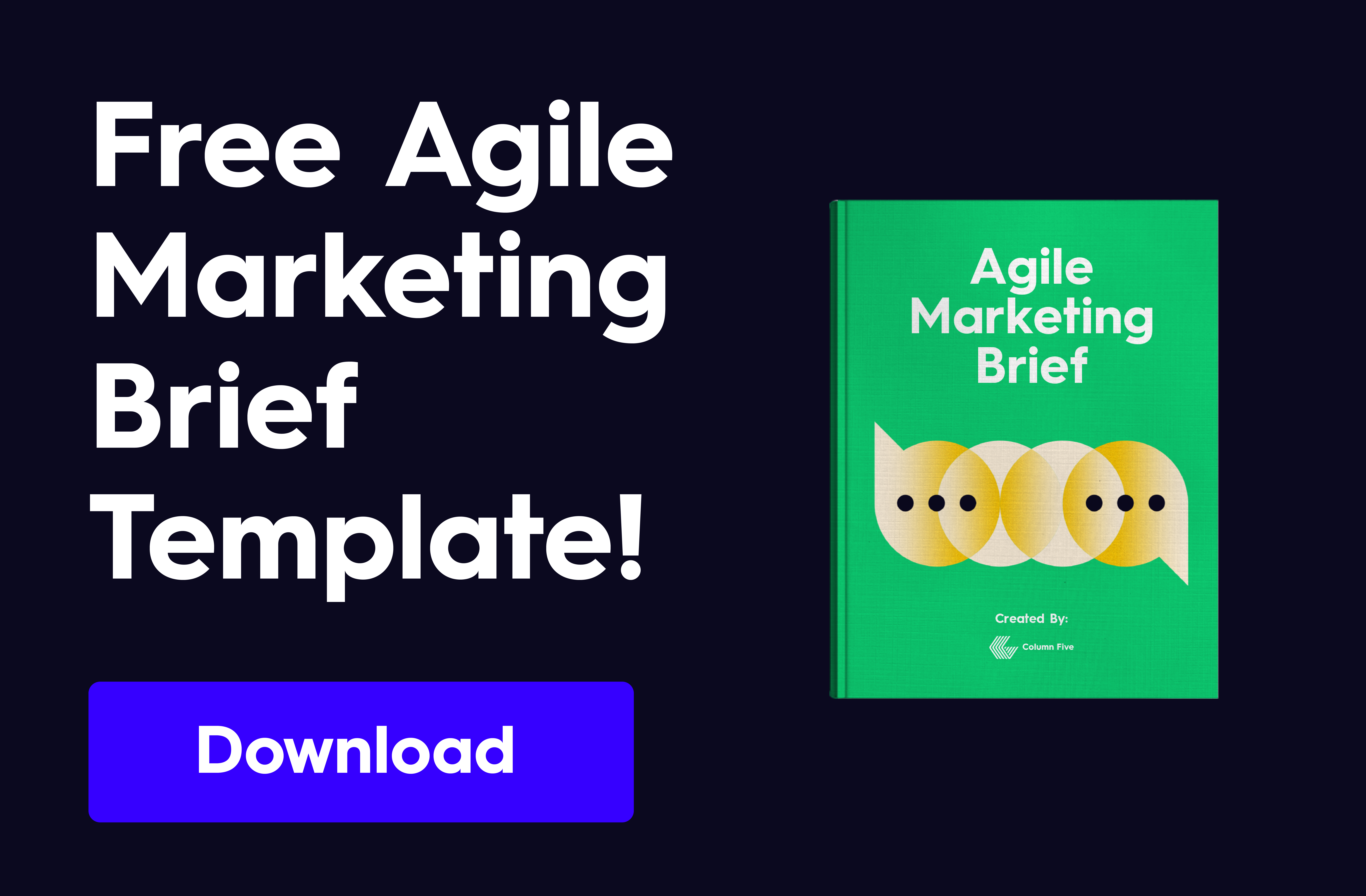For a lot of marketing folks, the past few years have been tough. Rapid tech advancements, along with budget cuts, mean marketers are stretched too thin and asked to do more with less. Big-picture thinking and long-term strategy planning have flown out the window as marketers scramble for immediate results.
When that happens, marketers start to chase quick wins and things fall through the cracks.
- Social posts ship, but research and testing stall.
- Reporting gets thinner, so decisions hinge on hunches.
- Campaigns spike, then fade, because there’s no long-term thread.
The simple fix? Work in small, focused sprints. Create a clear plan, make small moves, and learn fast. That way, the people you’re trying to reach get content that provides consistent value, not scattered activity.
Now, that doesn’t mean your long-term plays don’t matter. We’ve spent the last decade refining a framework to build lasting brands, and the truth is that it requires a balance between immediate wins and long-term brand strategy. But, in challenging times, it’s hard to justify a lengthy, comprehensive brand strategy revamp if your business is struggling to grow (or simply survive). Right now, you need to move quickly, invest intentionally, and focus on what’s working.
But how do you test your ideas to find out what’s working? Use our flexible framework to run lean experiments, get real answers from the market, and surface new opportunities worth chasing later. That framework is Agile Content Marketing, a test-and-learn approach that blends first principles thinking, the scientific method, and real-world marketing to answer big questions one experiment at a time.
This is the exact framework Column Five uses to help clients get clear, useful insights without a huge spend—and create a stronger content strategy that works. (For more on how we work with clients, learn more about our content marketing services.)
So, if you’re looking to try something new, mix up your approach, or improve your results, enjoy this deep-dive into all things Agile Content Marketing: what it is, why it’s different, and how to do it. (Or, hey, paste this article into your favorite LLM for a TL;DR.)
Let’s dive in.
TOC
- The Biggest Problem Marketers Face
- What Is Agile Content Marketing?
- What Is the Difference Between Agile and Traditional Content Marketing?
- Benefits of Agile Content Marketing
- How to Conduct an Agile Content Marketing Experiment
- How to Improve Going Forward
The Biggest Problem Marketers Face
Why do so many teams stumble and repeat the same mistakes? They don’t have the information needed to make smart choices.
Strong marketing sits on a foundation of essential truths that you know about your business:
- Who you’re for (aka the people you’re trying to reach)
- The problems those people face
- How your product or service actually helps them
- Why people should believe you can solve those problems
You get to these truths by asking the right questions, and you build your strategy around those answers. But as you grow and evolve, new questions arise and new answers are needed. Building a marketing strategy is, essentially, continuing to ask the right questions and getting solid answers. But there are many questions you can’t answer on your own, regardless of internal debates or hunches. At some point, only a good test will help you answer the question.
Unfortunately, teams often go with ideas that satisfy the most stakeholders—without testing. It’s no surprise that those plans often fail because they’re built around internal opinions, not real market needs. In other words, what seems right in a conference room often falls flat in the wild.
Yes, it can feel tedious to go through the testing process. But it’s important to challenge your assumptions and even previous “truths” you’ve learned, as some long-held ideas can be dated or built on wishful thinking.
Luckily, it doesn’t have to be as tedious or complicated as it may seem. What if your ideas could be validated quickly? What if those insights could easily guide your next move? Agile Content Marketing does exactly that. It builds a culture of curiosity instead of assumption.
So, What Is Agile Content Marketing?
Agile Content Marketing uses small, focused experiments to get quick answers. You start with one clear question (e.g., Is there a market for this new service? What formats do people prefer? Which message resonates more?), then run a rapid campaign to test it and collect real-time feedback.
Experiment. Execute. Optimize. That’s the rhythm.
These contained tests validate or challenge a hypothesis and generate timely insights to improve the next round. This approach replaces guessing with evidence that builds alignment, one experiment at a time.
For example, you might seed two message variations across short-form video, paid social, and an email send. You can watch behavior, gauge success, and use the winning message to inform the next sprint.
It seems like an obvious process, and everyone usually nods along when the idea of testing comes up. But few marketing organizations really implement it. Why? Failure stings, and getting tools approved or a pixel added can take forever in some orgs.
Also, an untested plan built quietly can feel safer.
- If the big plan works, someone looks brilliant.
- If it flops, there’s always a reason to blame. And sometimes it can be used as an excuse to get more budget.
But that approach is counterintuitive. Agile Content Marketing helps you work more efficiently in the long run by putting accurate results forward (and eliminating guesswork).
It can be scary because it asks teams to create in public, test, and iterate through evolving hypotheses. And that means making space for experiments that won’t land. But that’s the point.
Agile Content Marketing isn’t about assumptions or forcing an outcome. It’s about testing a specific hypothesis and getting a real answer. If you’re someone who wants certainty, it can make you uneasy. But it will also make your marketing stronger. It’s a proven way to get unstuck and learn what doesn’t work so you can find what does. (It’s also a great way to counteract the type of paralysis that perfectionism can cause.)
What Is the Difference Between Agile and Traditional Content Marketing?
Is Agile Content Marketing different from traditional content marketing (aka waterfall marketing)? Yes and no. Both aim to grow awareness and market share. The pace and process differ.
- Agile Content Marketing uses low-risk, scrappy experiments to gather information and adjust strategy.
- Waterfall marketing uses a linear process: complete the strategy, then build the creative, then launch—with each stage finishing before the next begins. This structured approach suits organizations that need campaigns synchronized across different products, markets, or teams before anything goes live.
Agile Content Marketing prioritizes quick, definitive answers and iteration.
Agile Content Marketing
Better for…
- Testing lean ideas
- Rapid production of quick-turn assets
- Real-time campaign management with room to pivot
- Strong engagement on smaller budgets and tighter margins
Waterfall Marketing
Better for…
- Campaign alignment across multiple verticals, personas/ICPs, and regions
- Complex brand campaigns
- Long-term strategy planning
- Longer production cycles with full-scale assets
- Larger investments and longer timelines
Both can work. Agile is especially useful for small teams or innovative groups inside large companies that need answers fast before scaling.
The Benefits of Agile Content Marketing
Testing matters because specific answers solve common marketing problems. Consider how many of these issues you’ve faced in the last year:
- Underperforming results
- Stagnation
- Limited budget
- Limited resources
- Fuzzy strategy
- Undifferentiated content
- Inconsistent messaging
- Messy measurement
- Market uncertainty
Agile marketing helps navigate and fix these across the board, improving:
- Efficiency and cost-effectiveness: Smaller, targeted experiments surface what resonates. Messaging improves. Spend goes further.
- Scale and impact: Once a controlled test works, you can scale with confidence.
- Effective feedback loops: Each cycle gets you closer to what the market wants. Continuous experiments evolve the conversation to meet people where they are.
- Business evolution: Insights from content and campaigns reveal new opportunities and directions for the business.
This is a strategy that embraces change through experimentation. If you can be flexible and go with the market, you can unlock more value and drive growth in a measured, dynamic way.
Ultimately, Agile Content Marketing turns insights into action, and curiosity into competitive advantage.
How to Conduct an Agile Content Marketing Experiment
This roadmap uses a 90-day cycle to test each hypothesis.
1) Formulate your hypothesis.
Time required: <15 days
Every experiment answers one clear question. Pick a single hypothesis to test. Ground it in research, using:
- Data analysis: Review historical performance, market trends, and behavior patterns.
- Customer insights: Analyze feedback, surveys, and engagement to understand needs and pain points.
- Competitive landscape: Study competitor strategies to spot gaps and openings.
- Innovation benchmarks: Borrow smart ideas from other industries and adapt them.
For your hypothesis, make sure it’s:
- Specific: Define exactly what changes.
- Measurable: Tie it to metrics.
- Relevant: Align it with business goals and real customer needs.
- Innovative: Challenge assumptions or introduce a fresh angle.
With these inputs, write a clear, testable prediction. Example: “Personalized content based on user behavior will increase engagement by X%.”
Example: We used this same process to evaluate whether to expand into a new AI marketing venture called Copper Key. After diving into market research, customer research, our competitive landscape, etc., we identified key opportunities for this new venture. But we needed a proper test for market demand, so we started with one hypothesis: “Implementing a paid campaign that promotes the benefits of AI to our existing personas will provoke leads.”
2) Design a small-scale experimental campaign.
Time required: 15 days
With a hypothesis in place, design an experiment that isolates variables.
Start with our free Agile Marketing Brief to outline:
- Goal
- Hypothesis
- Audience
- Messaging
- Formats
- Channel
- Measurement
- Budget
- Timeline
Create content next. Build lightweight MVPs that are tailored for different audiences. Produce variations to test across key buying touchpoints. Focus on those known pain points and growth opportunities. (If helpful, borrow from these content ideation tips to spin up lean options.)
Example: To test Copper Key, our team ran three LinkedIn sprints, each two weeks long. Each sprint A/B tested different messages and visuals to see what landed emotionally.
3) Launch the campaign and observe its performance.
Time required: 60 days
Make sure to test that your tracking works before launch. Then execute and watch closely.
Monitor your results in real time and tweak small elements for clarity, reach, or efficiency. Those adjustments should not break the integrity of the test.
Example: For Copper Key, we built planned check-in points to monitor performance, refine audiences, and adjust spend as relevant.
4) Analyze collected data for optimization opportunities.
After the test, analyze performance against your defined metrics.
- Confirm whether the hypothesis held up.
- Identify where to improve, scale, or stop.
- Bring the evidence to cross-functional partners to spark ideas and build buy-in.
Tip: These marketing KPI guidelines can help keep your analysis consistent.
Example: For Copper Key, we intentionally designed a three-phase experiment so that we could use insights to optimize messaging, visuals, and audience.
5) Iterate a new experimental campaign.
When your first campaign ends, momentum starts.
Feed your insights into a new hypothesis and continue your experiment.
- Optimize against the KPIs defined up front. You should also add qualitative signals from the community.
- Track leads and pipeline by experiment.
- Use results to reduce risk and make better strategic calls.
Example: With Copper Key, each sprint improved on the last, and all three outperformed the LinkedIn awareness CTR benchmark of 0.68%:*
- 1st run: 3.54% CTR
- 2nd run: 4.06% CTR
- 3rd run: 5.45% CTR
*Industry Average CTR for Awareness Ad Campaigns on LinkedIn industry (per The Verdict 2.0 Report by Directive)
This low-risk, high-reward experiment gave us valuable insights to guide our larger business decisions—now and in the future.
- We learned what type of messaging and creative drives stronger CTR with the right audience.
- We further refined our audience to identify our specific market.
- Although the response was not enough to warrant a full build-out of a parallel brand, we determined we could successfully merge our AI services into our core business to maximize our offerings.
All in all, this simple experiment saved us significant time, money, and energy, as well as a few internal arguments. Most importantly, the insights we learned from this campaign gave us a deeper understanding of our audience, which will inform future campaigns.
How to Improve Going Forward
Agile Content Marketing gets better with practice. Each cycle compounds learning, so the key is to stay agile.
- Don’t get tied to one idea. If a test stalls, write a new hypothesis or try a different experiment against the same hypothesis.
- Share your findings. Sales and marketing both benefit from what you learn. For more ways to connect teams, try these sales and marketing alignment tips.
- Scale your experiments. When something works, expand with more content and promotion.
Above all, remember that fear of failure will always be in the room. And that’s ok. Greet it by name, thank it for trying to protect you from everlasting shame, and move forward knowing you will not die if your idea for reaching a new market with a new message doesn’t work the first time.
P.S. Sometimes it’s a little too scary to face that failure alone. If you need a partner to back you up, see our tips for finding an agency with the right expertise, or find out more about how we work. We’d be happy to help you turn your ship around.






Excellent guide